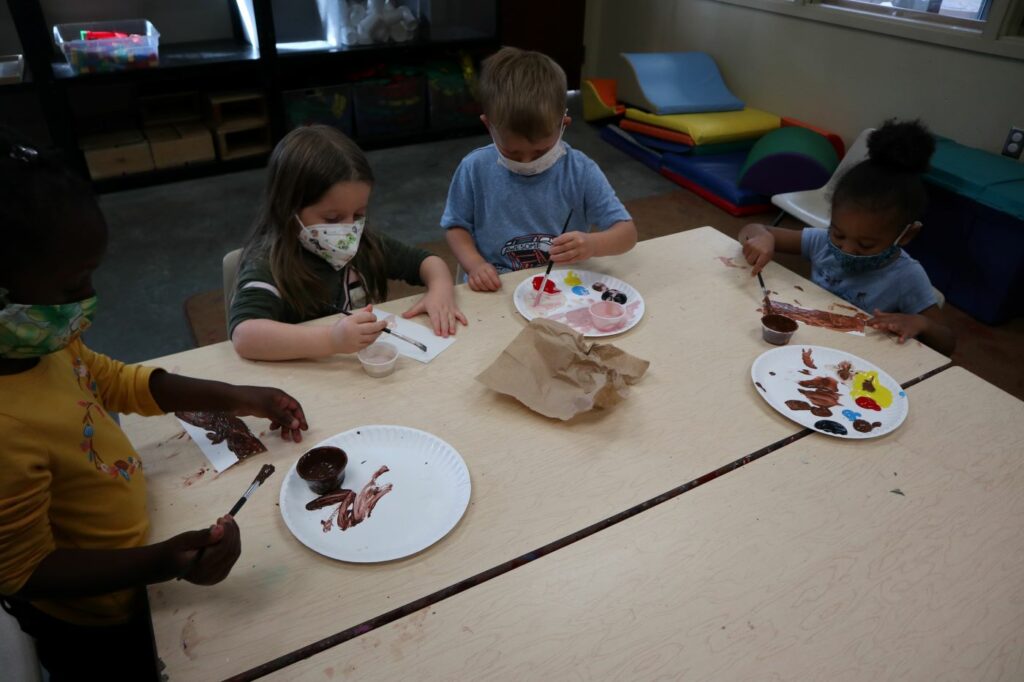Classrooms within the A. Sophie Rogers School for Early Learning are mixed-age, so a preschool room contains 3-, 4-, and 5-year-olds. At the start of the school year children were very observant of each other’s sizes and concerned some children were “too small” to be in preschool. Teachers discussed they are all different sizes; Ms. Vanessa is older than Ms. Oliva but much shorter. Children were very confused by this at first, but the more teachers talked and normalized the idea, children accepted it into their daily truth and working knowledge. These conversations continued over many weeks during varying times of the day as children noticed differences in their bodies, skin, and other features.
When a new topic or issue emerges in the room, teachers go to the library and get many books for children to explore. The books focused on diverse cultures, body types, skin tones, and family structures. Adults can help children increase their awareness and understanding of their individual and social identity and its aspects (race, ethnicity, gender, ability) by inviting them to explore their characteristics and finding the words that best describe those characteristics. While reading literature on positive racial identities, children could engage with and relate to the content. Bodies are Cool by Tyler Feder became a quick favorite with its engaging illustrations and depictions of varying body types. Children pointed out similarities with their bodies and people they knew (family members and loved ones). They practiced generalization skills when every child shared a previous experience/idea that were prompted by illustrations/situations presented in the stories. For example: “My grandma has a breathing machine; she uses it to sleep well at night” Teachers encouraged children to elaborate on these ideas and express complete sentences. When they chose words to describe themselves and people, some children gravitated to the words black, white, boy, girl. Others preferred to develop their terms to describe people and themselves, such as brown, pink, person with glasses, person with a dress. Teachers also compared ethnicities, and children realized the coexisting similarities in skin color and physical appearance compared to the differences in languages and culture; noticing that a teacher and a peer were very similar physically but came from different countries.
After looking at the book, Bodies are Cool by Tyler Feeder the class started to discuss what makes each child different. They considered skin color, hair color, eye color, shape, size, and many other ideas. They started an art exploration by looking at their hands finding a multi-Cultural crayon color or marker that matched their skin tones. They traced their hands and added details. Some children added moles and freckles or scrapes and cuts. Others requested primary colors to add painted fingernails. In the end, they had 18 unique hands. One thing discovered though, was that the markers and crayons were not exact copies of their skin tones so that lead to mixing their own paint to get the perfect color. This turned out to be harder than expected. Children used varying amounts of brown, white, black, red, yellow, and blue.
After making individualized shades, children wanted to use the paint to create self-portraits. First, they studied appearances in mirrors before using pencil to draw out features. Next, children used photos of themselves to create an image of their face. Teachers provided the children with both pieces of art and discussed which and why they liked it and then they continued to add art mediums and create a self-portrait. After that, children outlined their pencil marks in black marker, finishing by using the custom skin tone paints. While this project was occurring in the classroom, children were also interested in Baby Yoda and were labeling diagrams of his body parts. With the extra pencil sketch of children’s self-portraits, children wanted to label parts of their faces. Teachers and children worked on adding words, either upper or lower case, depending on each child’s fine motor development like eyes, nose, and ears.
As you can imagine this project and process took weeks going into months. Children kept bringing new ideas and questions to teachers and continued to explore new conversations and topics. At the end of the project work, teachers plan to bring this all together and have children make their own body collages with their self-portraits, photos, hands and customs skin tone paint swatches. Teachers and children will discuss similarities and differences and support each child to formulate their own words to describe their own self-identify and who they feel they are.
(Click to Enlarge)











